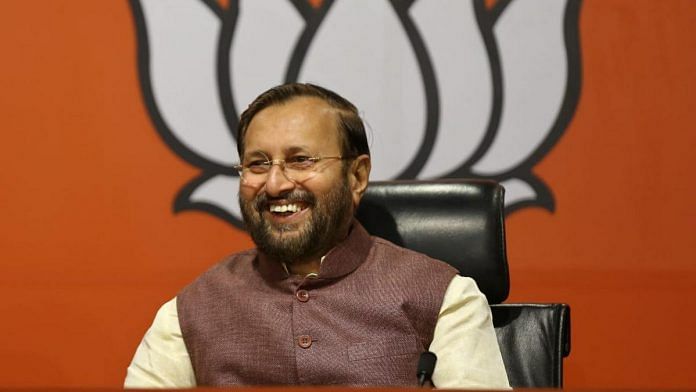New Delhi: Union Environment Minister Prakash Javadekar Sunday termed senior Congress leader Jairam Ramesh’s objections to the 2020 draft Environment Impact Assessment (EIA) notification as “unfounded” and based on “misinterpretation”.
In his letter, dated 25 July, Ramesh had said the draft EIA reduces public participation in all the steps of the environment clearance process “by lessening the notice period for public hearings and doing away with them for a large category of projects”.
The new EIA draft has been widely criticised by experts and activists, who say it has adopted a regressive approach in a departure from the existing 2006 version, and that it fosters non-transparency and encourages environmental violations.
Also read: Elephant or cow, Hindutva doesn’t give two hoots about animal welfare. Deaths are political
The history
India notified its first Environment Impact Assessment norms in 1994, under the Environment (Protection) Act, 1986, setting a legal framework for regulating activities that access, utilise, and affect (pollute) natural resources. The then government had enacted Environmental Protection Act in 1986 in the wake of the Bhopal Gas Tragedy in 1984.
Since the enactment of the law, all development projects need to go through the EIA process for environmental clearance. The projects are assessed based on their potential environmental impact and based on these assessments, they are granted or denied clearance.
The 1994 EIA was replaced by the 2006 modified draft. On 12 March this year, the MoEFCC further redrafted it in order to make the existing norms “more transparent and expedient”.
Significant shifts
The two most significant changes in the new EIA draft are provisions for a post facto clearance of projects, and abandoning the public trust doctrine.
Projects operating in violation of the EPA can now apply for clearance.
This draft is a reiteration of a March 2017 notification for industrial units and other projects operating without clearance.
In case of violations, all a violator needs to do are two plans for remediation and resource augmentation corresponding to 1.5-2 times the “ecological damage assessed and economic benefit derived due to violation”.
“The Appraisal Committee shall stipulate the implementation of EMP, comprising remediation plan and natural and community resource augmentation plan corresponding to the 1.5 times the ecological damage assessed and economic benefit derived due to violation in case of the suo moto applications or two times the ecological damage assessed and economic benefit derived due to violation in cases reported by any Government Authority or found during the appraisal of Appraisal Committee or during the processing of application if any by the Regulatory Authority, as a condition of Environment Clearance,” the draft reads.
This essentially means that in cases of a violation reported by a government authority or by the regulatory authority processing an application, the violator under the Environmental Management Plan (EMP) process shall be only liable for remediation and resource augmentation equivalent to 1.5-2 times of the ecological damaged and the economic benefit derived from the violation.
As for late applicants, a fee of Rs 2,000-10,000 per day shall be paid by the project developer for the period of delay.
The Supreme Court held on 1 April that “ex post facto environmental clearances” are contrary to law. “Environment law cannot countenance the notion of an ex-post facto clearance. This would be contrary to both the precautionary principle as well as the need for sustainable development,” it said.
The new draft also states that violations can be reported only by the government and the project proponent themselves and not by citizens. The draft says that violation cases will be dealt, based on the project developers suo motu, disclosing that they have broken the law. This means that the reliance is on the project developers to disclose when they have broken the law.
Also read: International Day for Biological Diversity — we need to recognise our solutions are in nature
The contentious EIA exemptions
The new draft exempts a list of projects under the ambit of the EIA. Under Clause 26 of the EIA draft, 40 different types of industries will be exempted from the need for prior environmental clearance. This includes projects labelled as ‘strategic’ by the government.
The draft also says that no information on “such projects shall be placed in the public domain”. Linear projects such as roads and pipelines in border areas are also exempted from the list. The ‘border area’ is defined as “area falling within 100 kilometres aerial distance from the Line of Actual Control with bordering countries of India”, which could cover much of the Northeast.
Further construction projects of up to 1,50,000 square metre shall also be exempt from EIA norms. Additionally all inland waterways and national highways projects are exempted from prior clearance.
The debate
Activists argue that the new draft by the government makes it easier for industries to escape environmental accountability.
Conservationists say that the new draft significantly diminishes the scope of the EIA and fundamentally diminishes its process, by reclassifying industries that don’t require environmental clearance, limiting public engagement and normalising environmental violations.
Project developers on the other hand complain that the EIA regime dampened the spirit of liberalisation, leading to red tape (excessive bureaucracy) and rent-seeking.
Also read: Global warming could be reducing lifespan of reptiles and amphibians, says new study




Please write the application and make it lucid for a layman to understand, who is not well aware of all these laws and their implications. I am not sure whether the people are raising questions even without understanding the issue reported here.
How to I rise my voice against to EIA draft please anyone Help me
Please stop this and let us live
Please stop this and let us live
Cancel the act